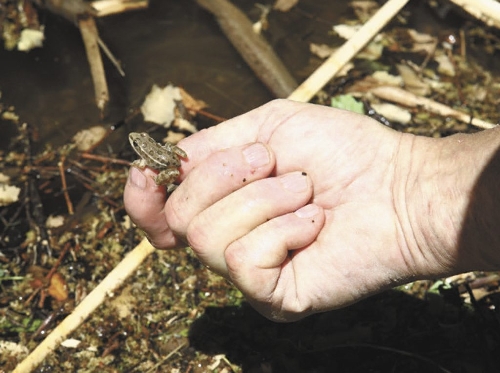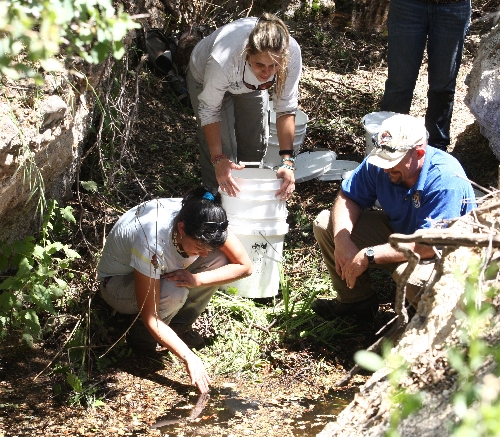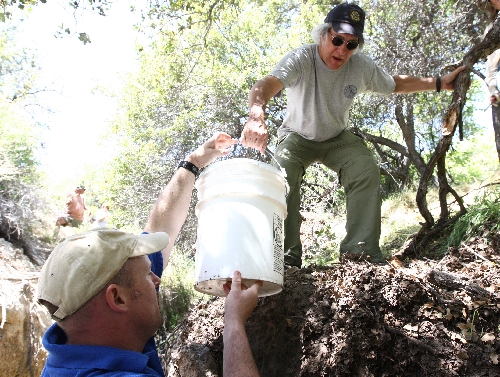Biologists hope new home keeps frogs from croaking
Every frog has its day. That's why a platoon of biologists recently strapped buckets on their backs and hauled a dozen rare froglets and 158 tadpoles to a remote, high-elevation spring on the Arizona side of Lake Mohave between Laughlin and Kingman.
They hope their effort to establish a new population of relict leopard frogs in their native range near the Colorado River will help preserve the species whose numbers are estimated to be between 1,200 and 2,500 in the wild, not counting tadpoles.
Last year's count, considered to be a minimum or underestimate, turned up only 551.
"The problem is finding safe harbors," said Jef Jaeger, research assistant professor at UNLV's Public Lands Institute and School of Life Sciences.
"We want to find places that lack exotic intruders like bullfrogs and crayfish, and have reasonably good habitat," he said.
The April 29 delivery day at Union Pass Springs just happened to be the third annual Save the Frogs Day, an international conservation recognition day. Save the Frogs Day was observed by environmentalists, life science professionals, students and frog fanatics who staged 120 events in 20 countries, from Australia and Brazil to the United Kingdom and the United States.
Sponsored by the Santa Cruz, Calif.-based, nonprofit organization, Save The Frogs!, the events attracted more encompassing crowds of amphibian lovers. A rally at the Environmental Protection Agency headquarters in Washington, D.C., focused on the fact that nearly one-third of the world's 6,485 amphibian species -- of which most, 5,576, are frogs and toads -- are on the brink of extinction because of human activities.
"When we save the frogs, we're protecting all our wildlife, all our ecosystems and all humans," said founder Kerry Kriger.
Such factors as habitat destruction, disease, pollution, pesticides, invasive species, climate change and over-harvesting for food and pets have taken their toll on frogs worldwide.
Relict leopard frogs are no exception, and the multi-agency team of state and federal biologists from Nevada and Arizona wanted to make a hands-on contribution to Save the Frogs Day by transplanting some that had been raised at a National Park Service laboratory in Boulder City.
They were hatched from egg masses collected from Lake Mohave's Black Canyon, one of the few places on the planet where the frogs are found.
TADPOLES AND FROGLETS
Research assistant Rebeca Rivera nurtured the tadpoles with daily feedings of chopped and peeled organic cucumbers, Romaine lettuce, alfalfa pellets and hard-boiled eggs. After they morphed into froglets -- young frogs that are a fraction as big as fist-sized adults -- they dined on tiny crickets. The three-year program is funded in part by $270,000 from Clark County through its Multiple Species Habitat Conservation Plan.
The 170 tadpoles and froglets endured a two-hour trip to the Union Pass Springs trailhead in the back of a van inside eight five-gallon plastic buckets.
Then the tadpoles were consolidated into six buckets that were put in backpacks for an uphill journey that wound for more than a mile, first through a flash-flood conduit beneath a highway, and then through shrubs and thickets and a kaleidoscope of cactus and wildflowers in bloom.
At a stopping point, in a puddle that flanks a spring-fed brook, the eagle eyes of U.S. Fish and Wildlife Service biologist Brian Wooldridge focused on a pair of red-spotted toads, their heads poking from moss while they engaged in a mating ritual called amplexus, Latin for "embrace." And that's a good thing for survival of that species.
"Red-spotted toads are common and a good indicator of a healthy riparian system," said Wooldridge, who works at the park service's Flagstaff, Ariz., office.
At the destination, a pair of relatively deep spring pools flanked by hummocks and covered by dense, scrub-oak branches, the team parked the buckets in the shade of a juniper tree and set out with saws and loppers to clear areas over the pools for frog-friendly sunlight to enter.
Jaeger said the trimming will not only enhance monitoring of the frog population, but will stimulate food development for the frogs.
"We'll get more moss to grow in here. There'll be more algae for tadpoles to eat and more light for the frogs to sun in."
After the work came the fun. Biologists formed a bucket brigade on the steep, rocky bank and carefully lowered the cargo to the edge of the pools.
First to be released were the froglets.
"I got him in the net," Wooldridge said as he lowered a small, green net toward the upper pool.
Then Mike Sredl, a wildlife biologist for Arizona Game and Fish, announced the release. "There goes No. 1."
Next, Sredl took another froglet in the net and gave it a soft pitch. It plopped into the pool and swam away.
Wildlife biologist Christina Akins of Arizona Game and Fish emptied a bucket of tadpoles into the lower pool.
"Slow, slow. Be gentle," Jaeger advised. "Be kind to your tadpoles. They're going from plastic containers into the wild."
The Black Canyon transplants are descendants of once-forgotten relict leopard frog populations that thrived along the Colorado River and its drainages in Nevada, Arizona and Utah. Scientists thought they had vanished and had chalked them up to extinction more than 60 years ago.
According to National Park Service biologist Ross Haley, relict leopard frogs were probably widespread in the region until the Colorado River was dammed in the 1930s to form Lake Mead. An unknown number of their old habitats succumbed to the bottoms of both lakes Mead and Mohave.
FROGS REPORTED IN 1872
Chronicled accounts of relict leopard frogs date back to 1872, when a specimen collected along the Virgin River in Washington County, Utah, was reported three years later to be the species.
For several decades, scientists debated its identification because of confusion centered on another leopard frog species in the Las Vegas Valley that was identified in 1906 but is now extinct.
Scientists observed relict leopard frogs in the wild until the late 1940s but they thought they had gone extinct some time after 1950 after the last specimens were collected from Berry Spring in Washington County.
In his research, Haley came across a 1974 correspondence from Lake Mead National Recreation Area noting that frogs existed south of Overton Beach, but it was unclear what kind they were.
That set him and a colleague, Randy Jennings, on a mission in 1991 to find any thriving populations . Frogs that were caught and compared with specimens from the Smithsonian Natural History Museum in Washington, D.C., confirmed they were relict leopard frogs.
Six years later, Jaeger and David Bradford discovered three more populations at sites along Lake Mohave.
The fate of relict leopard frogs lies with a conservation team that manages populations under a voluntary conservation agreement.
Translocation efforts have introduced the frogs to about 10 additional locations in their native range.
Having different locations to counter negative impacts from disease, pollution, flash floods and human activities near their habitats is a key part of the team's strategy to keep the relict leopard frog from being listed as a threatened or endangered, federally protected species. That would mean instituting costly programs to ensure the frog's survival.
"It's the classic case of, 'Don't put all your eggs in one basket,' " Haley said.
Contact reporter Keith Rogers at krogers@reviewjournal.com or 702-383-0308.





















